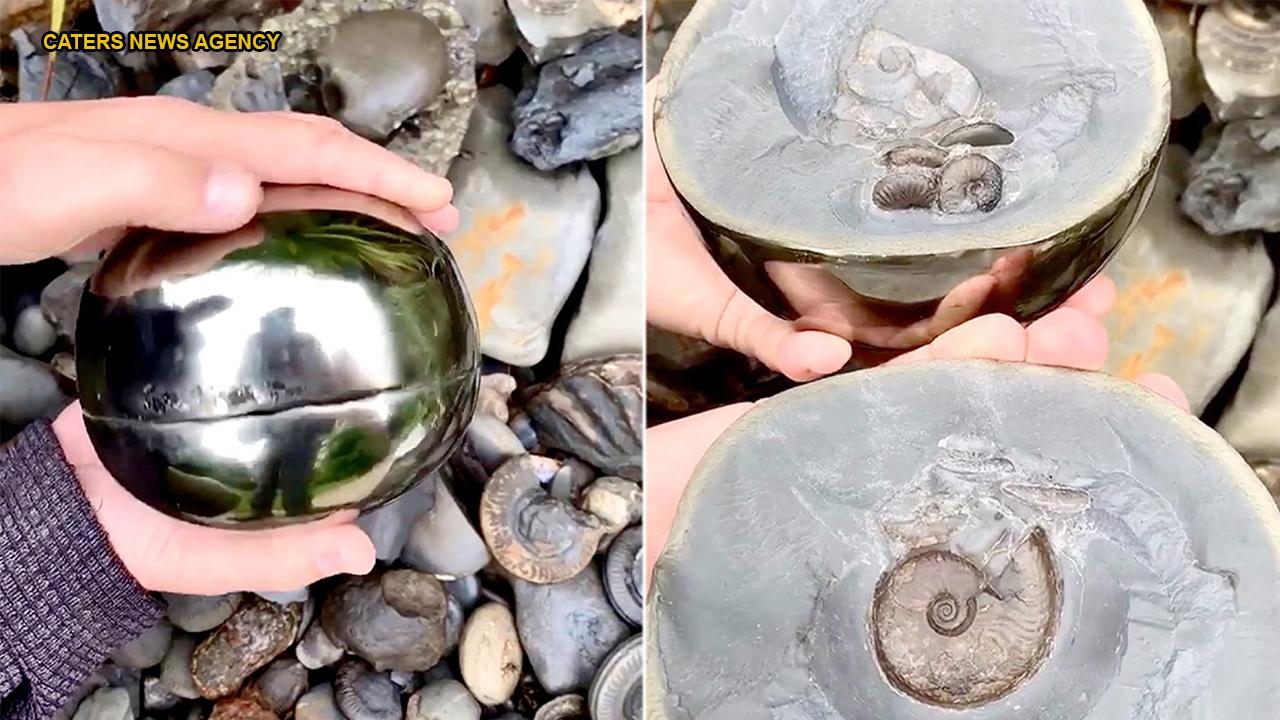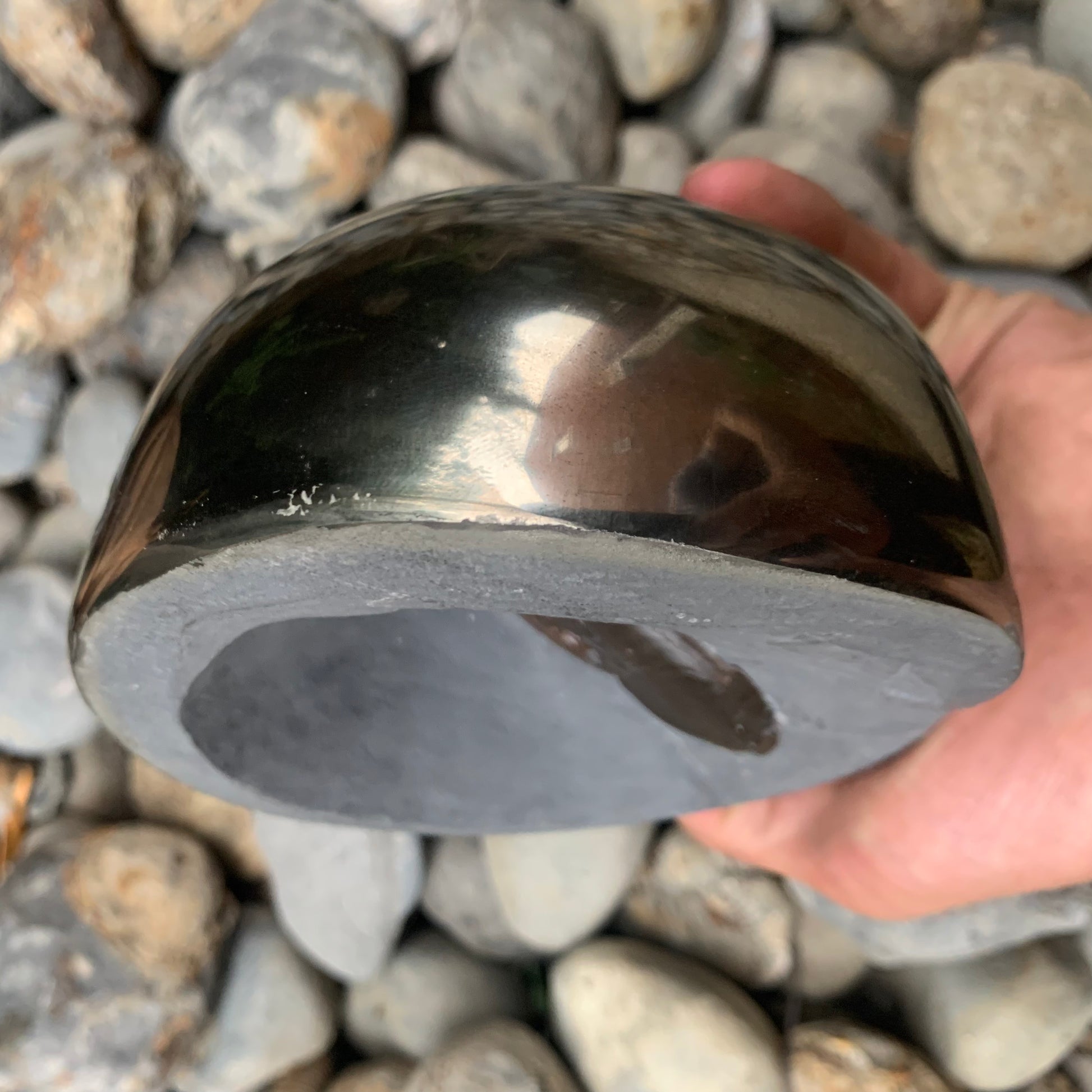A fossil hunter discovered a 185-million-year-old ‘golden snitch’ containing an extinct sea creature inside. The amateur archaeologist found spiral-shaped fossils of cleviceras, an extinct type of cephalopod creature, within the Quidditch ball-shaped rock.
Quidditch ball-shaped fossils are just some of the many discoveries made by amateur archaeologist Aaron Smith.
The medical student has found several fossils that date back to the Jurassic period on the beaches of Whitby in Yorkshire.
Perhaps the most spectacular is a 185-million-year-old fossil encased by what looks like a ‘golden canon’ ball.

It is technically a rock that is coated in iron pyrite, also known as ‘fools gold’, and if you shine this material, just like Smith did, then it turns shiny and gold.
The phenomenal piece of history is thought to be 185 million years old and was found on Sandsend Beach.
Mr. Smith, 23, is a seasoned fossil collector and continues to go and explore the seaside in hope of finding similar treasures.
He said: “In order to find fossils, pretty much anywhere in the world, you just need to put in a lot of dedication!
“The majority of the time there is nothing really to be found but every now and again, if you’re lucky enough, and something has appeared due to a storm for example, then you might find a rock with a fossil inside it.
“When you find a fossil, then the long intricate process begins of carefully removing the stone to expose the fossil, this can take hundreds of hours in many cases.
“It’s very exciting discovering the fossils. It makes it all worthwhile after spending months of searching.”
When the medical student opened up one of his freshly shined piece of iron pyrite he found spiral-shaped cleviceras fossils.
Cleviceras are an extinct type of cephalopod creature.
The best-known cephalopods today are probably squids and octopuses.
The golden-snitchlike spheres with a limestone core are actually common along the Yorkshire coastline and can be found among the stones and shales.
Mr. Smith has previously posted a video of the golden-snitch fossil online and captioned it: “Here’s a video of us opening one of our huge Cannon Ball fossils.

“The limestone nodule is coated in Iron Pyrite, meaning we can polish it to become Golden, seen in our previous videos.
“It still impresses me that these 185 million-year-old fossils are along our beautiful Yorkshire Coastline waiting to be found.”
‘Golden’ fossils reveal origins of exceptional preservation
Ammonite fossil From the Ohmden quarry, Posidonia shale lagerstatte. Credit: Sinjini Sinha/ The University of Texas at Austin Jackson School of Geosciences.
All that glitters is not gold, or even fool’s gold in the case of fossils.
A recent study by scientists at The University of Texas at Austin and collaborators found that many of the fossils from Germany’s Posidonia shale do not get their gleam from pyrite, commonly known as fool’s gold, which was long thought to be the source of the shine. Instead, the golden hue is from a mix of minerals that hints at the conditions in which the fossils formed.
The discovery is important for understanding how the fossils—which are among the world’s best-preserved specimens of sea life from the Early Jurassic—came to form in the first place, and the role that oxygen in the environment had in their formation.

“When you go to the quarries, golden ammonites peek out from black shale slabs,” said study co-author Rowan Martindale, an associate professor at the UT Jackson School of Geosciences. “But surprisingly, we struggled to find pyrite in the fossils. Even the fossils that looked golden, are preserved as phosphate minerals with yellow calcite. This dramatically changes our view of this famous fossil deposit.”
The research was published in Earth Science Reviews. Drew Muscente, a former assistant professor at Cornell College and former Jackson School postdoctoral researcher, led the study.
Golden ammonite fossils at Ohmden quarry. Credit: Rowan Martindale/ The University of Texas at Austin Jackson School of Geosciences.
The fossils of the Posidonia Shale date back to 183 million years ago, and include rare soft-bodied specimens such as ichthyosaur embryos, squids with ink-sacs, and lobsters. To learn more about the fossilization conditions that led to such exquisite preservation, the researchers put dozens of samples under scanning electron microscopes to study their chemical composition.
“I couldn’t wait to get them in my microscope and help tell their preservational story,” said co-author Jim Schiffbauer, an associate professor at the University of Missouri Department of Geological Sciences, who handled some of the larger samples.

The researchers found that in every instance, the fossils were primarily made up of phosphate minerals even though the surrounding black shale rock was dotted with microscopic clusters of pyrite crystals, called framboids.
“I spent days looking for the framboids on the fossil,” said co-author Sinjini Sinha, a doctoral student at the Jackson School. “For some of the specimens, I counted 800 framboids on the matrix while there was maybe three or four on the fossils.”

The fact that pyrite and phosphate are found in different places on the specimens is important because it reveals key details about the fossilization environment. Pyrite forms in anoxic (without oxygen) environments, but phosphate minerals need oxygen. The research suggests that although an anoxic seafloor sets the stage for fossilization—keeping decay and predators at bay—it took a pulse of oxygen to drive the chemical reactions needed for fossilization.
Geosciences students from The University of Texas at Austin with ichthyosaur specimens from the Posidonia shale. Credit: Rowan Martindale
These findings complement earlier research carried out by the team on the geochemical conditions of sites known for their caches of exceptionally preserved fossils, called konservat-lagerstätten. However, the results of these studies contradict long-standing theories about the conditions needed for exceptional fossil preservation in the Posidonia.
“It’s been thought for a long time that the anoxia causes the exceptional preservation, but it doesn’t directly help,” said Sinha. “It helps with making the environment conducive to faster fossilization, which leads to the preservation, but it’s oxygenation that’s enhancing preservation.”
It turns out, the oxygenation—and the phosphate and accompanying minerals—also enhanced the fossil’s shine.